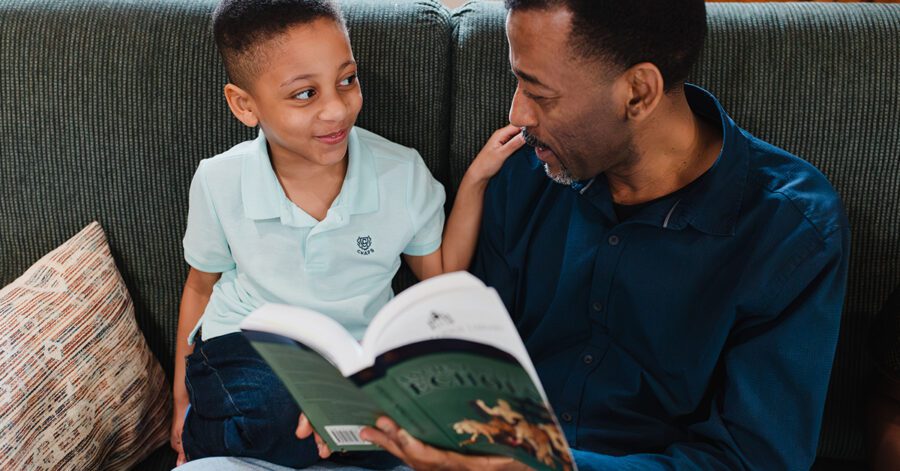How does phonics instruction fit within classical education? For homeschool parents seeking a phonics curriculum that complements the classical method of learning, understanding this connection is essential.
Classical education honors how God designed children to learn through the Five Core Habits of grammar. When phonics instruction integrates these classical skills, children don’t just learn to decode words—they develop habits of mind that serve them throughout their education. The Writing Road to Reading, rooted in the proven Orton-Gillingham method, exemplifies this integration beautifully.
As a Classical Conversations mom and curriculum developer, I’ve seen this approach succeed. Leigh Bortins used this very method to teach her own sons to read. In this article, we’ll explore how phonics works within classical pedagogy and why resources like The Writing Road to Reading align so naturally with how children are designed to learn language.
Learn How to Teach Phonics to Preschoolers: The Classical Approach
The Remarkable Design of Reading
By the time you finish reading this sentence, your brain will have made thousands of complex neurobiological connections. When your eyes start tracking the print across the page, a highly specialized bundle of nerves begins carrying the visual input to areas of your brain specializing in language.
Your visual cortex interpreted those squiggles on the page and arranged them into letters and word patterns. Your temporal lobe matched shape to the sounds of individual letters, sound blends, digraphs, and other letter combinations. As words begin to form, the parietal and frontal lobes further decode each word and begin adding meaning and comprehension.
Specific regions of the brain are activated and begin to integrate letters, sounds, words, meanings, grammar, and context. And all of these events occur within half a second.
The Gift of Language
We are indeed wonderfully made. Our gracious Creator has designed us with the gift of language. We are given the capacity to express thoughts, feelings, physical facts, abstract ideas, and spiritual truths to each other and to our Lord through speech and the written word. Uniquely endowed with the ability to speak, listen, comprehend, and read, humans are the only created beings with the incredible gift of language.
As parents, we daily witness this marvelous proclivity for language. We speak, and our babies watch and listen. In just a brief time, cooing became babbling, and soon we hear the first “Dada” and “Mama”! We witness our child’s language abilities explode in just a matter of a few years.
For example, by three, a child is speaking in complete sentences, asking questions, singing songs, recounting events, and saying prayers. They are beginning to show an interest in letters and sounds and can mimic “reading” a favorite story. Children at this age even understand that writing is an activity that represents language, even though they can’t identify letters yet. Our children are designed to learn language—both written and verbal.
Simple Homeschooling: Focusing on the Art of Grammar
Nurturing Early Language Development
Language is also a crucial way we engage with our children. We guide and encourage our children’s language development through simple, everyday conversations and by sharing stories, recalling events, telling jokes, giving instructions, asking questions, and expressing emotions. As our children develop spoken language, we begin introducing them to the beauty of written words.
We naturally begin making the connection between letters, sounds, and words, and our children become aware that whole words consist of a sequence of sounds. Written words become opportunities to expand our children’s love for language. As they become aware of this new world, they are ready to read. And we become aware of our new role. We are ready to teach.
Why Reading Instruction Requires a Guide
However, we may feel intimidated and unsure. Where do we start? How do we start? Part of the reason this step feels less natural is because the act of reading necessitates direct instruction, unlike the act of speaking. Learning to read requires the acquisition of the grammar of written words, which we know as phonics.
Most of us have long forgotten those early lessons of learning short and long vowel sounds or initial consonant sounds, but thankfully, we have trusted literacy resources to remind us of phonics rules. Since the late 1600s, phonics instruction has been the fundamental approach to reading.
Taught with simple primers and slates, children in the 18th century learned to read, achieving an estimated 90% literacy rate. Over time, other unsuccessful methods were introduced for reading instruction, including whole-language and sight reading. However, in study after study, phonetic instruction has been proven to be the most successful method of teaching reading.
Try these fun phonics ideas with the Everyday Educator podcast
The Resurgence of Phonics Instruction
Within modern times, phonics instruction re-emerged in the early 1930s through the combined efforts of neuropsychiatrist Dr. Samuel Orton and psychologist Anna Gillingham. The Orton-Gillingham method was developed and has become the gold standard for phonics education. This systematic phonics program is the basis for most classical reading programs and is currently used in all types of educational settings and programs.
One of the most respected and successful programs based on the Orton-Gillingham method is The Spalding Method. The Spalding Method was developed in 1957 by Romalda Spalding, a gifted teacher and child advocate, who spent time studying directly with Dr. Orton. After several years of mentorship, Spalding wrote a text to help equip parents and teachers, The Writing Road to Reading.
This resource not only incorporated Orton’s proven phonics-based methods but also included techniques Spalding developed over her forty years of teaching students who struggled to read. Now in its sixth edition, The Writing Road to Reading has been used by thousands of students in public, private, and homeschool settings.
Why Classical Conversations Recommends The Writing Road to Reading
Classical Conversations has chosen The Writing Road to Reading as a primary resource to equip parents for reading instruction. In her book, The Core, Leigh Bortins herself testifies to the success of teaching her sons to read using Spalding’s method. In fact, she still has the original set of phonetic flashcards that she used and can recite all the phonemes!
One of the reasons The Spalding Method has proven so successful is that it incorporates classical pedagogy. The key elements of The Spalding Method align with a child’s natural bent; integrate speaking, writing, and reading into various subject areas; and incorporate the Five Core Habits of grammar—Naming, Attending, Memorizing, Expressing, and Storytelling.
How The Writing Road to Reading Integrates Phonics and Skills of Learning
Taking a closer look at how each of these habits are used in The Writing Road to Reading will help us discover and appreciate Spalding’s approach and understand why this integration of phonics, spelling, and writing creates such effective literacy instruction.
Naming: Building Vocabulary Through Phonetic Terms
By teaching children the appropriate name of each phoneme and the rules of pronunciation, parents help children develop a wide vocabulary of terms. Handwriting strokes, letter-sound combinations, phonetic rules, cues for pronunciation, and parts of speech all have specific vocabulary associated with them. Because children learn the language of phonics, they can recall needed phonograms, rules, or cues when tackling new words.
Attending: Careful Observation of Word Patterns
The Spalding Method requires students to attend carefully to the details of word patterns and rules. Each piece is taught within the context of writing, reading, speaking, and spelling. Students use all their senses to write, see, say, and hear as they decode and read words, phrases, sentences, and stories.
Memorizing: Retaining Phonetic Knowledge
Students retain phonics vocabulary by memorizing seventy phonograms and approximately thirty rules for pronunciation, spelling, and language comprehension. The phonograms and rules are arranged in sequential order from simple to complex and can be applied at any age level.
Expressing: Demonstrating Knowledge Through Activity
Students demonstrate their phonetic knowledge through activity. They recite, trace, write, read, and speak as they explore how words are formed. Students are also encouraged to reflect and share what they have learned and how they learned it, which “develops habits of mind that serve them well throughout their education and their lives.”
Storytelling: Fostering a Love of Reading
Although students are primarily focusing on learning the phonetic structures using the Spalding Method, Spalding also recognized the value of reading stories to children regularly. Included in The Writing Road to Reading is a section listing children’s books arranged by ability level. Parents are encouraged to regularly read to their children to foster a love of reading.
Reading together introduces children to quality literature of all genres, improves comprehension, increases vocabulary development, and promotes understanding of a story’s structure. As children read and listen to stories, they soon begin recounting and creating their own stories. Storytelling naturally follows reading good stories.
Learn more about the Joy of Reading Aloud
Conclusion: A Homeschool Phonics Curriculum Rooted in Wonder
From the first coo to the reading of a page, discovering the gift of language is a marvelous and delightful journey for both parents and children. When we help our children move from letter to sound to word, we are reminded that we are fearfully and wonderfully made. God has designed us to communicate through both the spoken and written word.
The Writing Road to Reading offers homeschool families a time-tested, classical approach to phonics instruction—one that respects how children learn, integrates multiple language skills, and honors the gift of literacy as part of God’s design. Whether you’re just beginning your homeschool journey or seeking a more effective phonics curriculum, this resource provides the guidance and structure you need to teach reading with confidence.
Interested in more early learning resources? Check out these articles:
- Three Steps to Interest Your Child in Reading
- Patterns-Unlocking the Mysteries of Language with Phonics
Bibliography
Bortins, Leigh. “‘Reading.’” The Core. Palgrave Macmillan. 2010.
Cothran, Martin. 2017. “This History of Phonics | Memoria Press.” Memoria Press. June 6, 2017. https://www.memoriapress.com/articles/history-phonics/.
“Documented Results Using the SPALDING METHOD® – Spalding Education.” 2022. Spalding.org. 2022. https://spalding.org/documented-results-using-the-spalding-method/.
Edwards, Scott. 2016. “Reading and the Brain.” Harvard Medical School. 2016. https://hms.harvard.edu/news-events/publications-archive/brain/reading-brain.
Houston, Suzanne M., Catherine Lebel, Tami Katzir, Franklin R. Manis, Eric Kan, Genevieve G. Rodriguez, and Elizabeth R. Sowell. 2014. “Reading Skill and Structural Brain Development.” NeuroReport 25 (5): 1. https://doi.org/10.1097/wnr.0000000000000121.
Romalda Bishop Spalding, and Mary E North. 2012. The Writing Road to Reading: The Spalding Method for Teaching Speech, Spelling, Writing, and Reading. Collins Reference, An Imprint of HarperCollins Publishers.





